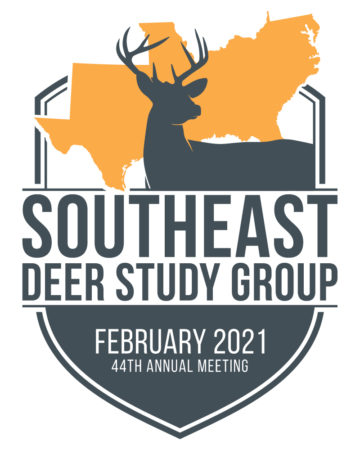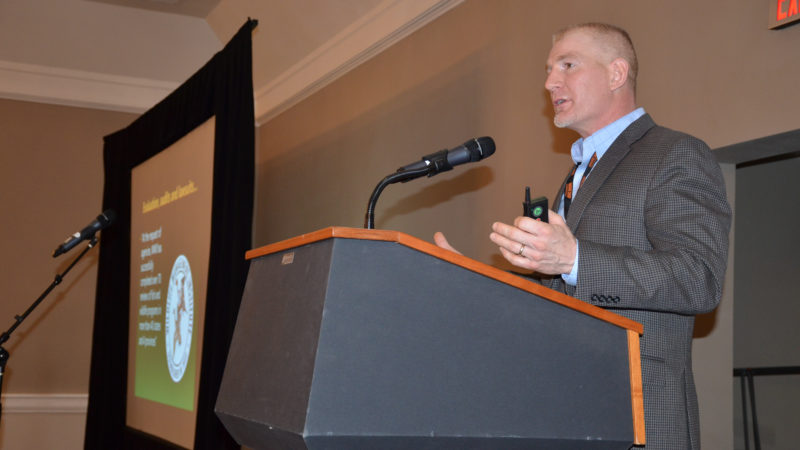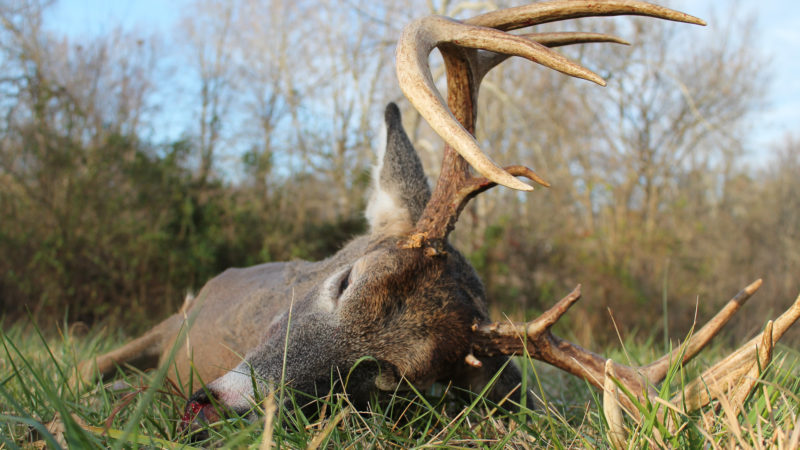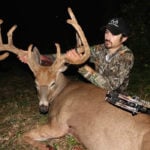Few things threaten deer and deer hunting more than Chronic Wasting Disease (CWD). This disease impacts all cervid species, including whitetails, mule deer, caribou, elk, and moose. It is caused by a prion, which is a misfolded protein.
Sadly, these prions are shed by infected deer, and can remain in the environment for lengthy periods. Most spreading takes place on localized levels by deer-to-deer or deer-to-environment-to-deer transmission. However, some human-based factors, such as transporting both live and dead deer, spread the disease, too.

There is still no approved treatment, and it is 100% fatal once contracted. Furthermore, there are few proven practices to slow the spread of CWD. Fortunately, there is news that a small percentage of deer express higher resistance levels to the disease, but it’s still 100% fatal once contracted. This jeopardizes not only deer but also deer hunting, wildlife management, conservation, and more.
Because this threat — and so many others — continue to impose risks on whitetails, researchers are working tirelessly to combat them. Part of this entails the sharing of information, which led to the Southeast Deer Study Group and its annual meetings.
This year, we attended the virtual event, and pulled together some of the latest information on CWD. Below are five key discussions from the event.
Tracking CWD Spread More Vital by the Day
It quickly became clear that while some state agencies are making CWD a priority, others aren’t. CWD-positive state agencies annually spend an average of $1.5 million on the disease. While states without the disease spend anywhere from nothing to $500,000.
That’s bothersome, because since there is no cure or remedy for the disease, wildlife agencies that don’t have the disease should be working just as hard to keep it out as those who are working to contain it. It isn’t going away.
Take Pennsylvania for example. CWD prevalence continues to rise. It’s increased from less than .01% in 2012 to almost 1.5% in 2020. That might seem insignificant, but it isn’t. Sample testing reveals that prevalence rates compound, and grow over time.
How do agencies gather this data? Tissue samples. In some states, samples are gathered only during deer season. Sometimes, hunters are required to submit their deer for sampling. In other cases, it’s completely voluntary. Furthermore, some agencies gather samples year-round, and use roadkill and other means of procurement to obtain them.
Another major hurdle agencies are facing is fast, efficient testing methods. Fortunately, it appears an answer could be on the horizon — RT-QuIC (real-time quaking-induced conversion). According to, Marc Schwabenlander, CWD research and outreach program manager for the University of Minnesota, this is the future of CWD testing. It has higher sensitivity, is adaptable to more tissue types, can detect CWD earlier, and produces faster results than other testing options available to researchers.
Once test results are in-hand, it’s necessary to package the data in a readable manner. It also requires extensive monitoring. This is why one group is working to develop a new dashboard to track CWD prevalence. This will help biologists, researchers and others to monitor the spread, and even the prevalence rate for specific areas, yet do so in a fast, easy, organized manner.

Increased Efficiency of Managing CWD Zones
Another part of the process for CWD-positive states is adapting to how agencies list (and eventually hopefully delist) CWD counties. Jeremy Brown, assistant deer program coordinator for the Arkansas Game & Fish Commission, as well as several fellow biologists, stressed the importance of slowing the spread.
This includes establishing CWD zones, and placing certain restrictions on these areas. Then, increased surveillance is put in place. This is taking place in Arkansas, as well as other areas.
In the Natural State, a county is included in the CWD zone if a CWD-positive deer is discovered in the county, or within 10 miles of its border. That said, they are working to incorporate a more scientific approach.
This potential new system could devise a strategy to remove low-risk counties from the CWD zone after a period of time. Risk assessment will hinge on numerous risk factors. Overall, this system will be an innovative way to manage CWD zones. Hopefully other state agencies will take notice.
Deer Hunters Are Wiling to Help Stop the Spread
One thing is clear — researchers, biologists and other professionals combating CWD can’t do it alone. They need the help of the public to achieve necessary goals.
“Despite the increasingly widespread apparent prevalence of this disease, few options to control or manage it have been successful,” said Sonja Christensen with Michigan State University. “Many of the disease-management options available to state wildlife agencies rely on deer hunters complying with new regulations or voluntarily changing behavior following suggested best management practices for harvesting and handling potentially infected animals.”
Fortunately, according to Christensen, hunters are becoming more educated about CWD, and thus, are more willing to help out. Christensen’s team has been creating short, 2-minute videos for deer hunters that demonstrate good practices for reducing the spread of CWD. They believe hunters who are more aware of the issues CWD presents will be more apt to aid in the management of this disease.
In a survey mentioned at the meeting, nearly 2,000 people were polled. Of those, 33.6% said they actively avoid known CWD zones, and 58.7% are moderately or extremely concerned. In that same pole, approximately 25% of hunters had no interest in paying into a CWD fund, but 75% were willing to on some level, with an average input of $15.12.
“We all must realize that science is changing, the public view is changing, and I feel like our new CWD risk assessment tool is a good step in adapting to this change,” Brown said. “We recognize that hunters are part of the solution and are the best tool we have at combating or managing CWD.”
CWD’s Economic Impact Is Not Good
The elephant in the room is the potential economic impact CWD holds. Scott Chiavacci, an ecologist for the U.S. Geological Survey, discussed how cervids financially support numerous industries and sectors, as well as wildlife and natural resource agencies. If CWD eventually has a widespread population-level impact — and the data suggests that it could — this will lead to many potentially-unsolvable problems.
“We used expert elicitation to gather data and information about CWD’s financial effects on state agencies, captive cervid operators, private landowners, cervid-related tourism, and organizations and companies tied to cervid hunting,” Chiavacci said. “To date, we have spoken with 97 professionals representing 67 government agencies and non-governmental organizations.”

Plans are being drafted to accurately predict future economic impacts under various prevalence and spread scenarios. If CWD spreads to the point of limiting or preventing hunting, it could impact conservation, property values, land sales, land leasing, tourism, manufacturing, and more.
Obviously, rural communities where hunting is more common will be impacted the most. For now, there is no discernable decline in hunter participation in most states, but it’s complicated to gauge, and things could change.
“This research will illuminate the magnitude of CWD’s impact in the United States and may inform management decisions and highlight research priorities,” Chiavacci said. “We anticipate results being available in 2022.”
Mike Foy of Wisconsin’s Green Fire also stresses the impacts CWD could have on these industries. In Wisconsin alone, when analyzing annual retail sales, license sales, economic output, taxes, jobs, and more, CWD threatens more than $1.3 billion. In the Southeast, that total is $9.5 billion. Foy said that, if CWD decreases Wisconsin’s rural land value by just $100 per acre, $2.3 billion will vanish.
We Must Learn From the Past
Foy made it clear that while CWD has the potential to impact the economy, it’s already striking the deer herd itself. The Badger State is a prime example of how serious CWD can get, and many states are following in the footsteps of Wisconsin — when they shouldn’t be.
In parts of Sauk County, Wisconsin, CWD prevalence rates in bucks have increased from less than 1% in 2002 to 60% in 2019, and has risen to 40% in does during that same time frame. Renowned CWD researcher Dr. Edmunds is commonly referenced for his 30% threshold notation for a population-level impact. And Wisconsin is witnessing it now.
Foy, along with Thomas Hauge, both put things in perspective at the meeting. According to their report, the Wisconsin DNR receives $22M annually from deer license sales, which is more than 75% of its wildlife program budget.
“Deer and deer hunting contribute over $230 million in local, state and federal taxes to Wisconsin, on nearly $900 million in annual retail sales, said their report. “The annual economic output of deer and deer hunting exceeds $370 million, supporting over 15,000 Wisconsin jobs, with a total economic multiplier effect of over $1.3 billion. These figures don’t begin to fully account for the value of deer for outdoor recreation & local food resources, tribal and ecosystem benefits, R3 progress, and a huge contribution to rural real estate values.
“If current CWD prevalence and distribution increases in Wisconsin continue – and there is no indication that they won’t – sooner or later these golden fawns will quit dropping,” it continued. “When that happens, a cherished part of the Wisconsin culture and fall traditions will be lost. Wisconsin is on track to effectively lose its deer herd to CWD in the coming decades. Without development and practicable implementation of miracle treatments, implausible genetic solutions, or elusive vaccines, your state will likely follow Wisconsin’s tragic lead.”

 By
By 



